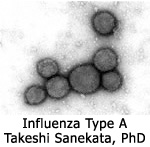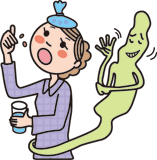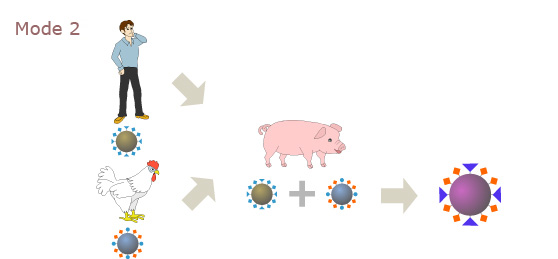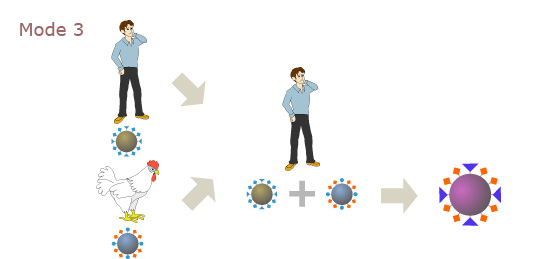Sanitation Control Basic Knowledge
What is influenza virus?

Influenza, commonly known as flu, refers to an acute infectious disease caused by the influenza virus. It mainly attacks the human respiratory tract and is highly infectious, i.e., it can spread over an extensive area within a short time. When a person is infected with the influenza virus, symptoms are often severe. There are generally three types of influenza. The first type is known as the flu and often breaks out in winter with symptoms similar to the common cold, the second type is called the bird flu which kills birds, and the third type is the new-type flu, a mutation of the avian flu, which kills people.
Influenza

An influenza virus particle or virion is about 100 nm in diameter and is estimated to infect about 5% of Japanese every year. Unlike the common cold virus, it is difficult to distinguish the symptoms. Common flu symptoms include sudden high fever, sore throat, and muscle pains. A runny nose, vomiting, and diarrhea similar to that observed in a cold are morbid symptoms. Among the elderly and children, the flu could advance, and pneumonia and encephalitis are common complications that could result. Therefore, flu can be fatal, especially among the elderly (over 65 years). In adults, infection from the influenza A virus is more severe than influenza B.
New-type virus

The new-type influenza has stricken the human world. For example, the Spanish Flu (H1N1) of 1918 killed 40–80 million people, including 45 in Japan, the Asian Flu (H2N2) of 1957 killed 2 million people, and the Hong Kong Flu (H3N2) of 1968 killed 1 million people. The new subtype H5N1 that has emerged recently is extremely virulent and has proven to be communicable among birds and humans. It’s a matter of time before the virus becomes communicable among people. It is estimated that the outbreak of H5N1 can kill 150 million people in the world.
By 1 April 2007, 291 people were reported to be infected by H5N1, which included 171 deaths. What is noteworthy is that most people killed by H5N1 were young and had a good immunity. This situation, known as the cytokine storm of the host as a result of infection, which causes an overreaction of the body’s immune system such that in strong immune systems (i.e. young adults) the cytokines ravage the body.
Three modes of mutations of H5N1:

As the virus mutates continuously, it became communicable among humans, thus forming a new type of influenzavirus. The Spanish Flu of 1918 may be the result of avian flu mutation.

When pigs are infected by influenzavirus of birds and humans at the same time, the genes of both types of influenzavirus combine together on pigs, thus forming a new type of influenzavirus.

When humans are infected by the influenzavirus of birds and humans at the same time, these viruses regroup in the human body and become a new-type influenzavirus. The Asian Flu of 1957 and the Hong Kong Flu of 1968 could be the result of modes 1 and 2.
The influenza virus proliferates very fast, and one virion can multiply into 1 million virions in a day. Moreover, its mutation capacity can be 1000 times higher than that of humans. Combining the proliferation and mutation speeds of the influenza virus, an evolution that takes 1 million years in humans can be achieved by the influenza virus in one year. Though the virus cannot survive in most cases following mutation, some virions do succeed. This makes it harder for the human immune system to resist the influenza virus. The first jump-species infection of H5N1 was reported in Turkey in January 2006, and subsequently, the person → person → person infection was reported in May 2006. Based on estimates by the UN, about 150 million people will be killed when the H5N1 pandemic breaks out. However, epidemiologist Dr. Michael Osterholm from the University of Minnesota of the USA warns that the deaths could be 180–360 million. According to late WHO Director-General Lee Jong-Wook (died in May 2006), “It’s too late to discuss whether the new-type flu is possible but the matter of when.” This shows how virulent and crucial the new-type flu is.
How do you prevent infection?

- To prevent initial infection, maintain a high energy to fight the flu.
○ Avoid exhaustion and get adequate sleep.
○ Get enough nutrition and rest. - To prevent infection
○ Wash hands and mouth frequently.
○ Avoid visits to crowded places.
○ Cover your mouth and nose with a tissue when sneezing and coughing, or wear a mask. - Keep your nose and throat moist.
○ Wear a mask.
○ Use a vaporizer. - Continue sanitation control measures.
○ Vaccine (it is said that it takes half a year for the output of vaccines for the new-type flu). - Dilute the viral density.
○ Maintain adequate ventilation to reduce the viral density.
○ Disinfect the environment or make the virus unable to survive.




